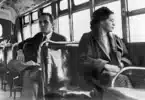In 1955, Rosa Parks was on her way home from her job at a department store. It had been a long day, but as Parks would later explain, she wasn’t more tired than usual. Her source of exhaustion came from years of enduring racial discrimination and hatred. When the bus driver told her to give up her seat so white passengers could get an extra row, Rosa decided she had had enough. Her refusal to move sparked a national surge of activism against the systemic racism infecting the United States. In this article, we’ll explore 15 of the most important facts about Rosa Parks, one of the most important Civil Rights icons.
#1. Rosa Parks was arrested for refusing to give up her bus seat in 1955
On December 1, 1955, Rosa Parks was returning home from work. The bus system was segregated, which meant white people got the first rows on the bus, while Black people were made to sit at the back. Rosa was sitting where she was supposed to, but the driver told her she needed to move further back to give white riders more room. When she refused, the police arrived and arrested her.
#2. Because of her protest, Rosa Parks is known as the “Mother of the Civil Rights Movement”
The Civil Rights Movement was the most significant time for equal rights in 20th-century America. For over a century of discrimination, legalized segregation and racial violence after the Civil War, Black Americans and their allies fought for equality, but from 1954-1968, a massive wave of activism and progress ushered in a better era. Rosa Parks’ refusal to give up her bus seat represented a major turning point. It led to the Montgomery Bus Boycott, a year-long protest against segregation, and eventually, a court case that ended bus segregation in Alabama.
#3. Rosa lost her case
After Rosa’s arrest, E.D. Nixon, the president of the Alabama NAACP, and a few friends paid her bail. Just four days later, Rosa’s case went to trial. The NAACP organized a boycott of the bus system and encouraged people to either stay home, walk or take a cab in support of Rosa. Rosa lost her case and was fined $14.00. While she may have lost in court, Rosa’s story was far from over.
#4. Rosa’s protest sparked the Montgomery bus boycott
After Rosa’s case ended, activists decided to keep protesting the segregated bus system. They formed the Montgomery Improvement Association (MIA), which was designed to organize and manage the boycott. Martin Luther King Jr, who was just 26 years old at the time, was elected president. Rosa served on the executive board of directors and worked briefly as a dispatcher. In this role, she helped connect boycott participants with the rides they needed to get to work, school and other commitments. As part of their work, the MIA created a carpool system. Over 300 private cars were available at any one time along with 22 station wagons provided by churches. Thanks to this system, around 30,000 people were helped every day.
Martin Luther King Jr. was an important figure in the Montgomery bus boycott. Here are 11 facts about the Civil Rights icon.
#5. Rosa was arrested again in 1956
On February 21, 1956, a Montgomery grand jury indicted Rosa Parks, E.D. Nixon, Martin Luther King Jr, and 86 other people for violating Alabama’s Anti-Boycott Act. By participating in the bus boycott, they were technically breaking the law. The two most famous pictures of Rosa Parks – her mugshot and a photo in which she’s being fingerprinted – are from this arrest, not her original December 1, 1955 protest.
#6. Rosa Parks was not the first woman to stand up against bus segregation
Rosa Parks is the most famous person to refuse to give up her seat, but she wasn’t the first. Earlier in 1955, a 15-year-old Claudette Colvin refused to give up her bus seat when told to make room for a white woman. She was arrested. Rosa Parks was among the activists raising money for Claudette, but other civil rights leaders decided the “feisty” teenager wasn’t the right plaintiff for a larger case against segregation. According to Claudette, Rosa was the only adult to keep up with her the summer after her arrest. While Claudette’s story is not as well-known as Rosa’s, she still made an impact. In 1956, Claudette was one of the plaintiffs in Browder v Gayle, the federal case that led to the desegregation of the Montgomery bus system.
#7. Rosa knew about racism from a very young age
Rosa Parks, then Rosa McCauley, was born in Pine Level, Alabama. She grew up with her mother, brother and grandparents. When racial violence increased after World War I, Rosa’s grandfather would watch for the Ku Klux Klan, armed with a shotgun. In addition to learning to sew, cook and clean, a young Rosa would “keep vigil” with her grandfather on the porch. Rosa’s grandfather taught her to never accept poor treatment. When she was a child, a white boy threatened her. In response, Rosa picked up a brick, frightening the boy away.
#8. Rosa had one brother
Rosa’s brother, Sylvester James McCauley, was two years younger than her. He served during World War II in both the European and Pacific theaters. When the war ended, he moved to Detroit with his wife, Daisy, where they had thirteen children. Sylvester worked as a carpenter and employee of the Chrysler Motor Company. One of his daughters, Sheila McCauley Keys, wrote a book about her aunt called Our Auntie Rosa: The Family of Rosa Parks Remembers Her Life and Lessons, which was published in 2015.
#9. Rosa Parks’ husband was an activist, too
Raymond Parks proposed to Rosa on their second date and they married in 1932. At the time, Raymond was working with the Montgomery labor rights and fundraising for the defense of the Scottsboro Boys, nine Black teenagers falsely accused of rape. The work was so dangerous that supporters needed to meet secretly. According to Raymond, he would communicate a meeting’s day and time by standing in front of a specific street light and tying his shoe a certain way. Rosa called her husband “the first real activist I ever met.”
The Civil Rights Movement is one of the most famous social movements in history. Here’s our list of nine other human rights movements.
#10. Rosa worked in a variety of jobs
Rosa earned a high school diploma in 1933, which was fairly unusual for Black people at the time. However, it was difficult for Rosa to find a job worthy of her education. She worked as an insurance agent, office clerk, nurse’s aide and domestic worker. She also did sewing work at home to earn more money. Her mother and maternal grandmother, who made quilts, had taught her to sew. Rosa also received formal sewing training at the Montgomery Industrial School for Girls before her graduation.
#11. Rosa worked for the NAACP years before her bus protest
Rosa Parks is best known for refusing to give up her bus seat, but she’d already been involved in activism for decades. In 1943, she became a secretary for the Montgomery NAACP. She would investigate cases involving police brutality, murder, rape and racial discrimination. One of those cases involved the kidnapping and rape of a 24-year-old Black woman. When local police refused to prosecute the men, the Montgomery NAACP sent Rosa to investigate. She worked to form the Committee for Equal Justice and organized a letter-writing campaign to the Alabama governor. While a special grand jury was eventually created, the attackers were never indicted. In 1948, Rosa became the first NAACP state secretary.
Are you inspired by Rosa Parks’ activism? Here’s our list of courses on taking action for activists.
#12. After the Montgomery bus boycott, Rosa had to leave her home state
While the Montgomery boycott was successful and segregation on public transport was declared unconstitutional, Rosa faced many challenges. She and Raymond both lost their jobs and couldn’t find work again. They received death threats. Eight months after the boycott, Rosa, Raymond and Rosa’s mother moved to Detroit, Michigan, where Rosa’s brother lived. While some things were better, racism still infected the North, making it difficult for Rosa and Raymond to find consistent work and housing. Despite these challenges, Rosa continued to work for racial equality and freedom.
#13. Rosa worked for John Conyers’ office until her retirement in 1988
John Conyers was a young lawyer in Michigan, and when he began running for a new Michigan Congressional seat, a win was considered unlikely. In favor of his pro-labor beliefs, Rosa Parks volunteered for his campaign. In 1965, Conyers won his election and promptly hired Rosa to work in his Detroit office. This was her first steady job after the bus boycott. She worked for Conyers until her retirement in 1988.
#14. Church and religion were very important to Rosa
Understanding Rosa’s Christian faith is essential to understanding her as an activist. As a child, she attended the Mount Zion African Methodist Episcopal Church in Pine Level. Faith remained important to her as an adult. In her book, Quiet Strength: The Faith, the Hope and the Heart of a Woman Who Changed a Nation,” Rosa names the church as the one place where people can meet and educate themselves without unfair treatment. She describes the church as “the foundation of our community.”
Interested in other quotes about civil rights and freedom? Here’s our list of 10 of the most memorable.
#15. Rosa Parks died in 2005 at age 92
In 2004, Rosa Parks was diagnosed with progressive dementia, and in 2005, she died of natural causes at age 92. Several memorials were held. She also lay in honor in the U.S. Capitol Rotunda in Washington. She was the first woman and second Black person to lie in the Capitol. In Detroit and Montgomery, the front seats of buses were reserved with black ribbons. Rosa was interred between Raymond, who had died in 1977, and her mother.












